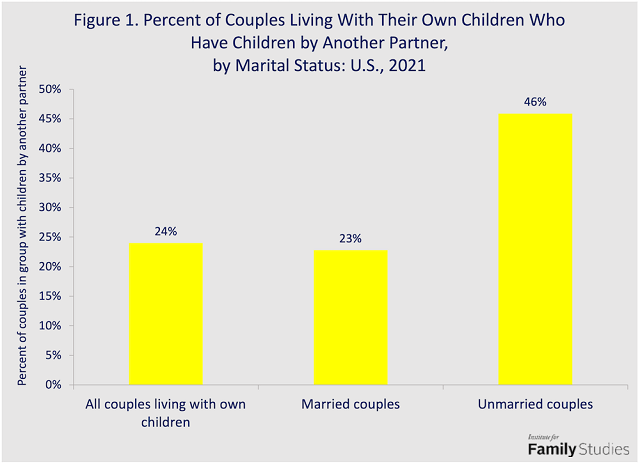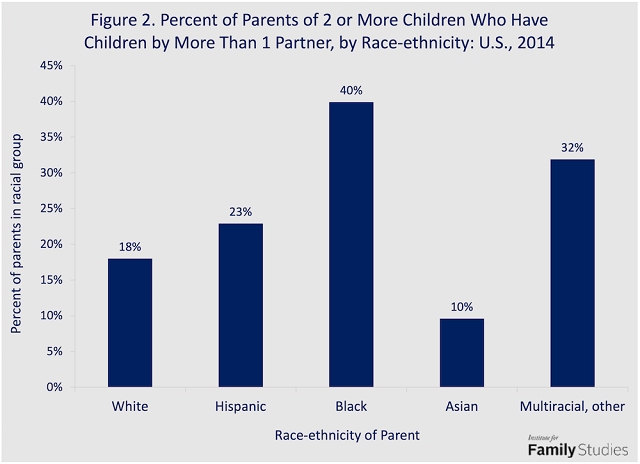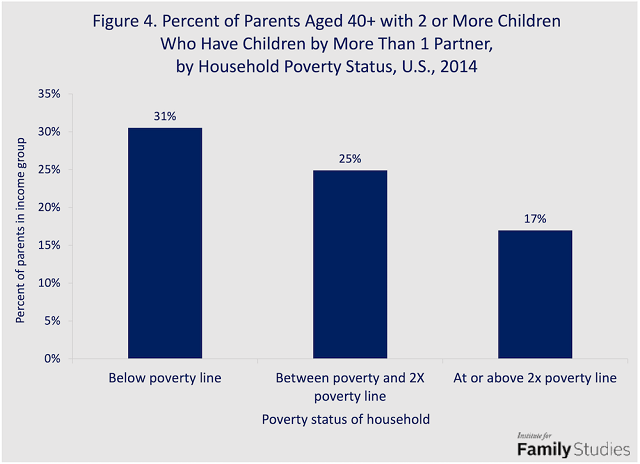Highlights
- Divided loyalties are twice as common among unmarried as married parents. Post This
- A substantial minority of U.S. parents have had children with multiple partners and have emotional ties, along with financial and caregiving obligations that extend across household boundaries. Post This
- Multi-partner fertility is more common among parents with less than a bachelor’s degree. Post This
In 2021, one-in-four couples in the U.S. who had a child together also had children by other previous partners.1 These parents have divided loyalties because one or both have emotional ties and financial obligations to the prior children, many of whom do not live with their biological father and mother. These feelings and obligations make it less likely that the parent will be able to provide either the current child or the previous children with all the love, supervision, and support that each needs to thrive.
The previous children may also be a source of conflict between the partners, particularly when family resources are meager or there are burdensome educational, housing, or medical expenses. And children may become resentful about the parental attention and financial aid received by their half siblings.
Divided loyalties are twice as common among unmarried as married parents, as shown in Figure 1. In fact, 46% of unmarried couples in 2021 had previous children by other partners, 2 versus 23% of married couples.3

Multi-partner fertility is more common among Black and multiracial parents than among white and Asian parents, as may be seen in Figure 2. In 2014, among parents of two or more children, twice as many Black parents (40%) as white parents (18%) had their children with more than one partner.4 A slightly higher proportion of Hispanic parents (23%) had children by multiple partners, whereas a lower proportion of Asian parents (10%) did.5

Multi-partner fertility is more common among parents with less than a bachelor’s degree, as may be seen in Figure 3.6 Eleven percent of college-graduate parents have had children by more than one parent, whereas the same was true of between 21% and 26% of parents with less education.

Financial insufficiency is both a cause and consequence of having children by more than one partner. In 2014, of parents aged 40 plus who had two or more children and were living in a household whose income was below the poverty line, 31% had children by multiple partners. Of those living in a household whose economic circumstances were between poverty and twice the poverty line, 25% had children by multiple partners. Of those in a household whose income was at twice the poverty line or more, 17% had children by multiple partners.7 (See Figure 4.)

Of all parents aged 40 plus who had children by multiple partners, 15% were living below the poverty line and 20% were between poverty and twice the poverty line. By comparison, parents in the same age group with two or more children who had all their children with only one partner, 8% were living in poverty, and 15% were between poverty and twice the poverty line.8
Other Risk Factors for Multiple-Partner Fertility
Mothers who began having children as teenagers are more likely to have had children by multiple fathers than those who began childbearing in their thirties. Fathers who have spent time in jail or prison are more likely to have had children by more than one woman. Among fathers of newborns in large U.S. cities, 30% of those with a history of incarceration had previous children by women other than the mother of the newborn, compared with 10% of fathers who were never incarcerated.9
Protective Factors
Mothers and fathers who themselves grew up with both biological parents until they were 15 years old are less likely to have children by multiple partners. The same is true of mothers who attend religious services frequently. Immigrant fathers are also less likely to have children with more than one woman.10
Implications for Family-Strengthening Efforts
Campaigns to improve child well-being by encouraging healthy marriage are complicated and challenged by the family realities described here. A substantial minority of American parents have had children by more than one partner and have emotional ties, along with financial and caregiving obligations that extend across household boundaries. Many of these parents have additional risk factors impeding their efforts to do well by their children, including low parental education, insufficient earnings, racial or ethnic prejudice, criminal records, and resentful feelings between them and their former partners, which can result in “gatekeeping” by the mother. The challenge for reformers is to devise recommendations and strategies to assist parents and strengthen family ties in these situations, as well as encourage young people who have not yet embarked on parenthood to get married before having children and to stay married.
Nicholas Zill is a research psychologist and a senior fellow of the Institute for Family Studies. He directed the National Survey of Children, a longitudinal study that produced widely cited findings on children’s life experiences and adjustment following parental divorce.
1. King & Valerio (2023). Table 3. Same-sex couples with children were excluded from these estimates.
2. Ibid.
3. Because 95 percent of U.S. couples with children were married, the number of married couples with previous children by other partners (nearly 10 million) greatly exceeded the number of unmarried couples in the same situation (just over one million).
4. Monte (2019). Author’s analysis of data in Table 4. Percentages are of parents in each racial group who had two or more children.
5. Ibid.
6. Ibid.
7. Monte, L. M. (2019). Author’s analysis of data in Table 5.
8. Ibid.
9. Carlson & Furstenberg (2006).
10. Ibid.












